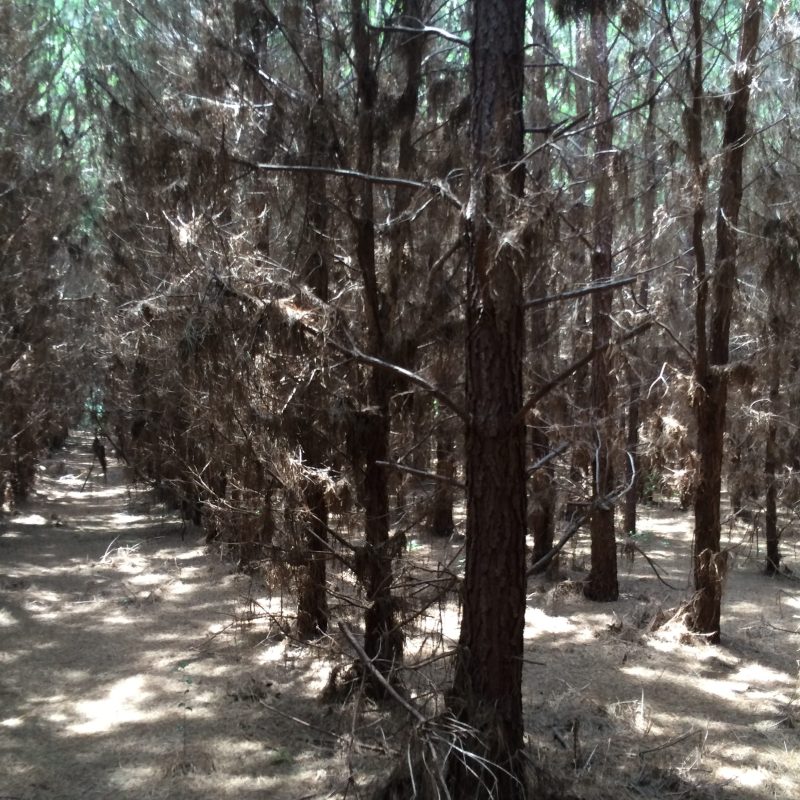Thinning is an important part of any forest management plan. Getting it right can be the difference between successful outcomes and persistent problems. One of the most common questions foresters get is, “Should I Thin My Trees?” It is an important question to ask and definitely needs a forester’s input on optimal timing. Thinning is part of managing the density of a forest stand to prevent issues with overstocking. If a stand is overstocked it causes multiple issues with the health and growth of a forest stand. Forest stands can permanently stunt when left in an overstocked condition and fail to produce the expected, optimal timber yield. Not thinning at the proper intervals results in lost growth even if the thinning is performed later. The key issue is competition, so managing density prevents excessive competition among trees. To understand how thinning works you must understand how trees grow.
–
Trees compete on a site for resources such as sunlight, water, and nutrients. As a young stand of timber develops, the trees initially have plenty of resources while they are young and small, but they begin to compete when they grow older. Initially the competition can be a good thing, encouraging taller and straighter growth habits and self-pruning of lower branches. As the stand develops though, the competition becomes a negative factor when the trees begin to experience stress from lack of resources, primarily sunlight but also nutrients and water. At this point the stand is considered overstocked, so thinning will improve the health and growth of the trees. Effective thinning removes inferior trees that will eventually become weaker and die. This allows a landowner to earn some timber revenue while improving growth and health down the road. The trees that remain after thinning are no longer competing with each other and respond with improved growth and health. This important forest management technique is one of the primary management decisions of timberland ownership.
Overstocked stands create multiple issues that cause negative outcomes. One of the primary issues is that trees in dense stands may become weaker and more susceptible to insect and disease outbreaks. It is very common for bark beetle outbreaks and other issues to take hold in overstocked stands and produce considerable losses. Thinning is a key management technique to prevent outbreaks. Overstocked conditions result in poor growth and can lead to a situation where trees have a lower portion of living foliage. Once this occurs, a stand can become locked in a slower growth that can’t be reversed. This causes a loss of both wood volume and quality by reducing the development of high value sawtimber and poles. Dense stands are also less desirable for wildlife. Thinning opens up the forest and allows more light to hit the forest floor which improves habitat by increasing plant diversity in the understory. Thinning at the right time, based on the forest conditions and stocking, produces better outcomes. During thinning, trees with form, disease, or other issues can be removed to improve the overall stand health. Determining when and how to thin is a function of having a good forest inventory and monitoring tree size and stocking. There is usually a period of time that is referred to as a “thinning window” when the stand is beginning to become overstocked but will still produce a thinning response. This varies based on forest conditions and is more of a function of the size and density of the trees than an exact age or predetermined point in time. The best practice is to determine when a forest is entering the thinning window and take advantage of the thinning benefits. Delaying thinning will result in less optimal outcomes. Similarly thinning too early or thinning incorrectly (too few or too many trees removed) can produce less desirable results. The key is to thin correctly and thin when forest conditions indicate it is needed.
Overall thinning is one of the best forest improvement practices available, and to get the most benefit it has to be done correctly. Far too often forest areas that need thinning are overlooked and go far too long before action is taken. You do not want to look into getting your timber thinned only to find out you should have done it 5-8 years ago or more. Worse still, you develop a southern pine beetle out break and loose timber or start to have timber die from competition. The best way to make sure you stay informed on when and to what extent to thin is to have a forest management plan and update it regularly. Working with a consulting forester to inventory your timber stand and plan out forest management is one of the best things you can do. A good consulting forester can make you money by assisting in determining when and how to thin properly. They can also assist in marketing timber harvested in a thinning along with other services like timber marking. You can get assistance through your Florida Forest Service’s County Forester as well. Work with your County Forester to enroll in the Forest Stewardship Program and get a management plan written at no cost to you. A forest management plan will cover thinning and other important practices to help you meet your goals. Determining when and how to thin is something that requires advice from a good professional forester. By working with a professional forester, you will avoid common pitfalls. If you think your stand may need thinning contact your county’s extension office, county forester, or a professional forester of your choice. Making those contacts are a great first step in getting the most out of a good thinning.
- Recent Drought Conditions Increase Pine Bark Beetle Risk - October 31, 2025
- Panhandle Landowner Assistance Expo – August 23 - July 11, 2025
- Tick Prevention – An Important Safety Measure When Working Outdoors - April 25, 2025

